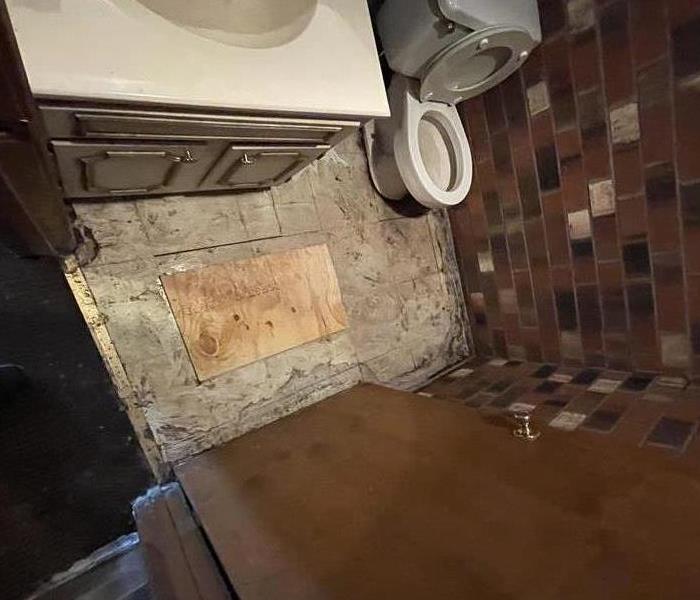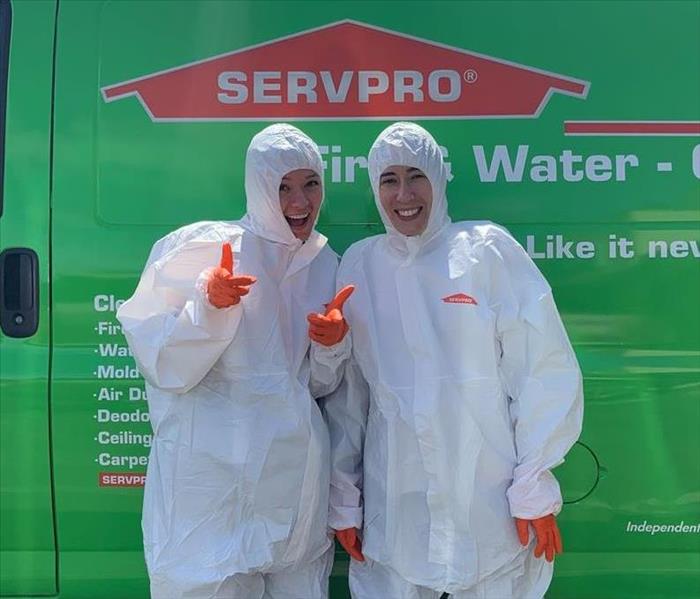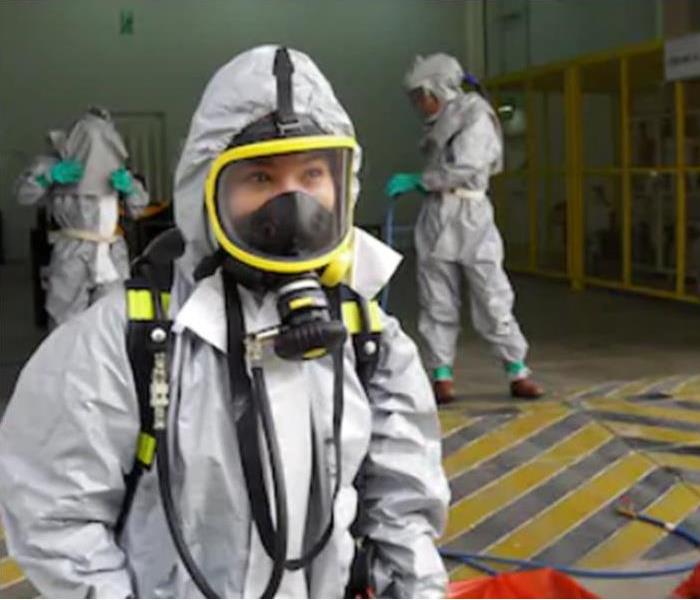Archived Biohazard Blog Posts
Sewage Backups Pose Risks
3/2/2022 (Permalink)
 Call your local SERVPRO!
Call your local SERVPRO!
Exposure to biological and chemical contaminants can pose serious health consequences. A failure to properly remove such substances can contribute to unhealthy and dangerous environments.
SERVPRO of Lee & South Chatham Counties certified technicians are trained to safely remove bio hazardous substances and dispose of them properly in accordance with OSHA and health regulations.
Sewage backups and dark water intrusions are more than nasty, smelly deposits – these damages also introduce harmful microorganisms into a structure. SERVPRO of Lee & South Chatham Counties certified technicians remove the sewage, contaminants, and moisture, and help ensure the structure is properly cleaned, disinfected, and deodorized
Equipped with the necessary safety apparatus and cleaning products, SERVPRO of Lee & South Chatham Counties help turn unsafe environments into clean, safe homes and offices.
SERVPRO of Lee & South Chatham Counties is the areas premier sewage cleanup company. Don't take the risk of doing it yourself. Call us for all your cleanup needs: (919) 533-6776.
We are proud to serve our local community. We are "Here to help".
What is Biohazard Cleanup and Restoration?
3/5/2021 (Permalink)
SERVPRO provides biohazard cleanup and restoration when a home or business has been affected by a trauma, sewage back up, chemical spill, hoarding, or human and animal wastes. A trauma clean up may consist of a suicide/death, homicide, blood clean up, or accident clean up.
Our technicians have received Blood Borne Pathogens Training and know how to properly clean and remove biohazard materials from the affected area. We provide the appropriate personal protective equipment (PPE) for our technicians to keep them safe from exposure to biological and chemical contaminants.
When cleaning an area affected by biohazard, we start by cleaning the area completely. We remove any biological materials, blood or chemicals in the area. This step may consist of wiping surfaces or removing materials that cannot be completely cleaned and disinfected such as fibrous materials. Then we sanitize and disinfect affected materials to stop the spread of biological and chemical contaminants. If necessary we deodorize the area so there are no remaining odors.
Flatten the curve - COVID19.
3/27/2020 (Permalink)
 We are trained and excellent at what we do. Let us help you, your family and community by becoming PROactive against this COVID19.
We are trained and excellent at what we do. Let us help you, your family and community by becoming PROactive against this COVID19.
Cleaning and disinfecting are part of a broad approach to preventing infectious diseases.
Exposure to biological and chemical contaminants can pose serious health consequences. A failure to properly remove such substances can contribute to unhealthy and dangerous environments. SERVPRO of Lee & South Chatham Counties is trained to safely remove bio hazards and dispose of them properly in accordance with OSHA and health regulations.
1. Know the difference between cleaning, disinfecting, and sanitizing
Cleaning removes germs, dirt, and impurities from surfaces or objects. Cleaning works by using soap (or detergent) and water to physically remove germs from surfaces. This process does not necessarily kill germs, but by removing them, it lowers their numbers and the risk of spreading infection.
Disinfecting kills germs on surfaces or objects. Disinfecting works by using chemicals to kill germs on surfaces or objects. This process does not necessarily clean dirty surfaces or remove germs, but by killing germs on a surface after cleaning, it can further lower the risk of spreading infection.
Sanitizing lowers the number of germs on surfaces or objects to a safe level, as judged by public health standards or requirements. This process works by either cleaning or disinfecting surfaces or objects to lower the risk of spreading infection.
2. Clean and disinfect surfaces and objects that are touched often
Typically, this means daily sanitizing surfaces and objects that are touched often, such as desks, countertops, doorknobs, computer keyboards, hands-on learning items, faucet handles, phones, and toys. Some schools may also require daily disinfecting these items.
Immediately clean surfaces and objects that are visibly soiled. If surfaces or objects are soiled with body fluids or blood, use gloves and other standard precautions to avoid coming into contact with the fluid. Remove the spill, and then clean and disinfect the surface.
Need Bio-hazard Cleanup Services?
Call Us Today
(919) 533-6776
3. Clean and disinfect correctly
Always follow label directions on cleaning products and disinfectants. Wash surfaces with a general household cleaner to remove germs. Rinse with water, and follow with an EPA-registered disinfectant to kill germs. Read the label to make sure it states that EPA has approved the product for effectiveness against whatever you are trying to clean.
If a surface is not visibly dirty, you can clean it with an EPA-registered product that both cleans (removes germs) and disinfects (kills germs) instead. Be sure to read the label directions carefully, as there may be a separate procedure for using the product as a cleaner or as a disinfectant. Disinfection usually requires the product to remain on the surface for a certain period of time.
Use disinfecting wipes on electronic items that are touched often, such as phones and computers. Pay close attention to the directions for using disinfecting wipes. It may be necessary to use more than one wipe to keep the surface wet for the stated length of contact time. Make sure that the electronics can withstand the use of liquids for cleaning and disinfecting.
4. Use products safely
Pay close attention to hazard warnings and directions on product labels. Cleaning products and disinfectants often call for the use of gloves or eye protection. For example, gloves should always be worn to protect your hands when working with bleach solutions.
Do not mix cleaners and disinfectants unless the labels indicate it is safe to do so. Combining certain products (such as chlorine bleach and ammonia cleaners) can result in serious injury or death.
5. Handle waste properly
Throw disposable items used to clean surfaces and items in the trash immediately after use. Avoid touching used tissues and other waste when emptying waste baskets. Wash your hands with soap and water after emptying waste baskets and touching used tissues and similar waste.
Keep your family and business safe during the COVID-19 outbreak.
3/13/2020 (Permalink)
 COVID-19 alert and cleaning special
COVID-19 alert and cleaning special
As stated directly by the CDC when it comes to routine cleaning and disinfection of households, we’d like to address the hot-topic of keeping safe during the outbreak of COVID-19.
Community members can practice routine cleaning of frequently touched surfaces like: tables, doorknobs, light switches, handles, desks, toilets, faucets, sinks, with household cleaners and EPA-registered disinfectants that are appropriate for the surface, following use by labeled instructions. The labels are important because they contain instructions for safe and effective cleaning using the product. It also includes precautions to take when applying the product, like wearing gloves and making sure to have good ventilation during product use.
The best offense and defense against this outbreak is having a good understanding of what you’re up against.
That's why it's important to focus on keeping your family HEALTHY and SAFE during this time.
If you own a business you should ensure it is CLEAN and SANITIZED properly.
If you are interested in having our professional team visit your home or business to offer a complete clean, top-to-bottom, including air PURIFICATION with a state-of-the-art electrolysis system, please contact us immediately by calling us, or click here to contact us via email.
How to clean and disinfect:
To properly clean and disinfect surfaces, wear disposable gloves. They should be tossed after each cleaning. If you decide to use reusable gloves, they should be dedicated for surfaces for COVID-19 and should NOT be used for other purposes or surfaces. Once you remove the gloves, immediately wash your hands afterwards. If a surface is dirty, they should be cleaned using a detergent or soap and water prior to disinfection.
For effective disinfection, diluted household bleach solutions, alcohol solutions with a minimum of 70% alcohol, and most EPA-registered household disinfectants are effective.
Clean your hands!
Wash your hands often, including right after removing gloves and after touching an ill person. Follow the 20-second rule when washing your hands. If soap and water are not available and your hands are not visibly dirty, using hand sanitizer that contains at least 60% alcohol may be used. If your hands are visibly dirty, always wash them with soap and water.
Key times to clean your hands include:
- After blowing your nose, coughing, or sneezing
- After using the restroom
- Before eating or preparing food
- After touching animals or pets
- Before and after providing care for anyone who needs assistance
If you’re looking to have your home or commercial space cleaned from top to bottom by our professionally certified bio-hazard team, please do not hesitate to contact us ASAP by clicking here.
We offer a full-service clean including bringing specialized atomizers to disinfect the air-space so you can live and breathe healthy with confidence.
For more information and additional resources, please visit the following links:
OSHA COVID-19 Website
CDC Home Care Guidance






 24/7 Emergency Service
24/7 Emergency Service

